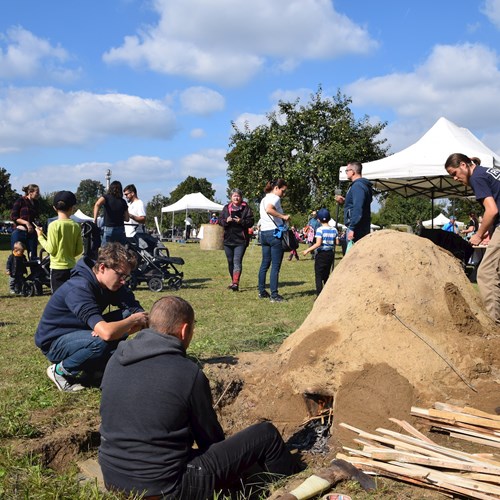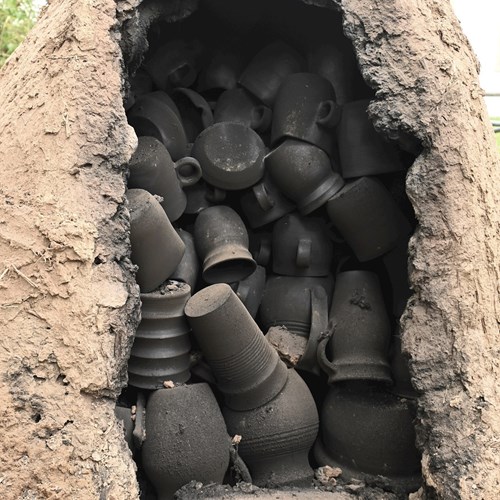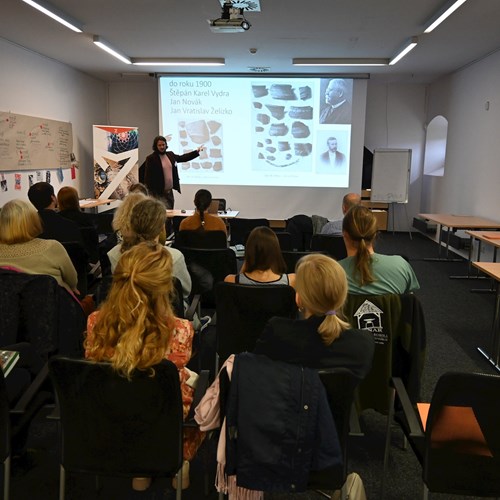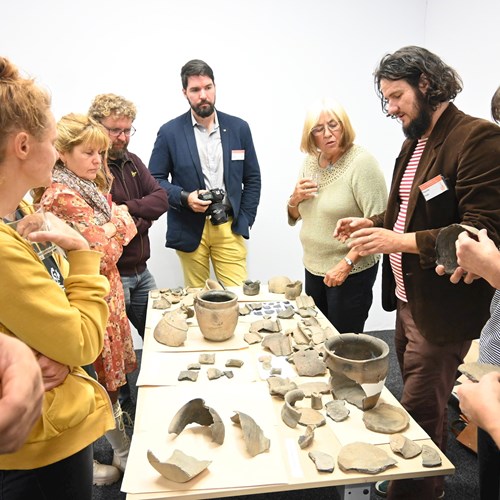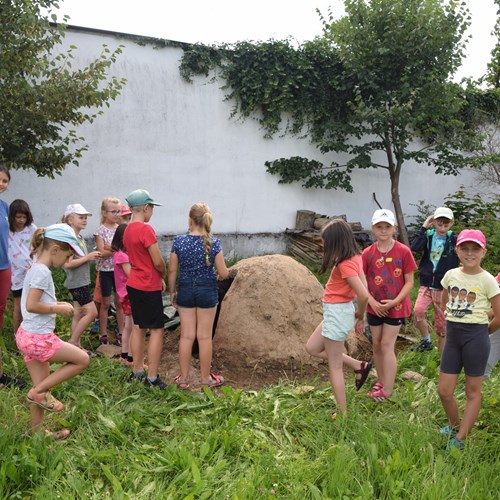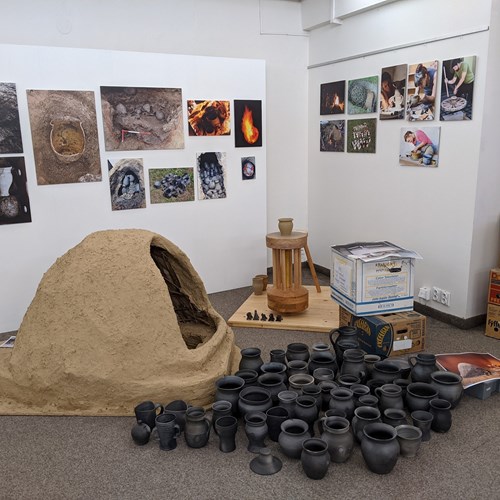Historical Pottery in 2021
The Historical Pottery (HP) project is focused on pottery making from the High Middle Ages, when it has developed as an independent craft, until its decline and extinction in the 1st half of the 20th century. The aim of the project is to explore the technology of historical pottery, its conservation and presentation.
HP comprises a scientific part based on a complex processing of archaeological pottery finds with the help of natural scientific analyses, experimental archaeology, historical and ethnographic sources, and modern documentation methods (3D modelling). This all creates a base for another part of the project, which is targeted at popularisation of historical pottery craft through workshops, lectures, exhibitions, social networks or reproduction of historical ceramic vessels.
HP stands on three main pillars: Tradition of pottery making as a historical craft and its legacy; Production technology of historical pottery and its study, and Experiment focused on exploration and popularisation of pottery making. The project has been operated under the auspices of the UNESCO Chair of Museology and World Heritage at the Department of Archaeology and Museology, Faculty of Arts, Masaryk University (DAM FA MU) and Chateau Žďár nad Sázavou, where it has a base with necessary facilities.
In 2021, a new logo and Facebook page of the project (Staré hrnce/Historical Pottery) were created and the transfer of necessary facilities to the Chateau Žďár nad Sázavou was finished. It also was the last year of the NAKI II project “Late Medieval Pottery as Part of Movable Cultural Heritage” (https://dask.zcu.cz/). The activities performed can be divided into two main groups: scientific research and popularisation.
Scientific activities
The processing of regional clay sources continued in 2021. Clay vessels imitating the medieval pottery were made with various techniques in collaboration with Tereza Zemancová (DAM FA MU), Eva Nová (Historická řemesla DANAR), Martin Cvejn (MC keramika) and Alexandr Králík (Keramický ateliér Saši Gr.; Fig. 1). Together with Martin Košťál (DAM FA MU), we started an experiment with 13th century pottery decorated with a tracing wheel, which will also continue in the following years (Fig. 2). The second traditional firing of smoked pottery has taken place in September, this time in a pottery kiln at Žďár nad Sázavou which was built in the summer of 2020 (Figs. 3–4). The aim was to verify and improve the properties of this construction type of pottery kilns, which were detected during the first firing in the autumn of 2020, and to fire vessels for the experiments with regional clay sources and with tracing-wheel decoration. The analysis of batches from pottery kilns in the given region has continued.
The “Triple Life of Medieval Pottery” conference, which was one of the outputs of the NAKI II project (Figs. 5–6), has taken place in the Chateau Žďár nad Sázavou in October. It was meant to present and discuss topics concerning the life cycles of medieval pottery (13th to 15th centuries) from manufacturing over usage through to decline, inclusive of its “rebirth” through archaeological excavations and the following phase of scientific analysis and evaluation. More than thirty participants from archaeological institutions in the Czech Republic and in Slovakia have taken part in the conference. They presented 13 papers, 4 posters and 6 pottery assemblages.
A special issue of the journal Archeologické výzkumy na Vysočině, dedicated to ceramics and containing 11 studies related to the NAKI II project, was published at the turn of 2021 and 2022. The studies cover the whole thematic spectrum of approaches to medieval pottery – experimental production of smoke-fired pottery, restoration of vessels, natural scientific analyses of pottery, possible sources of clay and manufacturing tradition of construction ceramics in the Vysočina Region, or analysis of batches from two medieval pottery kilns in the surroundings of Jihlava. Besides the assemblages from Vysočina Region, sets of finds from České Budějovice or Černá Hora near Blansko also are published. The activity within the HP project is represented by articles dealing with experimental production of smoke-fired pottery, results of natural scientific analyses of pottery from Počátky (Vysočina Region), preliminary analysis of the find of a pottery kiln in the U Skály street in Jihlava or presentation of an open database of ceramic clay sources in the Czech Republic.
The experiments carried out at Panská Lhota in 2012–2019 were analysed within the dissertation by K. Těsnohlídková “High and Late Medieval Pottery Technology. Pottery Production from 1200 to 1350 in the Bohemian-Moravian Highlands”, defended in the DAM FA MU and available online: https://is.muni.cz/th/ozfnb/?cop=3536218;id=300051.
Popularisation activities
Presentation of historical pottery making, including the firing of smoked pottery, was made during the “Rural Day” on 25 September, which is a traditional event attended by several thousand visitors. Apart from the firing procedure, visitors could also try to make pottery on a kick wheel, learn something about the technology of pottery production in the past or use 3D glasses for virtual reality to be transferred back in time to a medieval rural potter’s workshop. Historical pottery also was among the crafts which were presented during the “Day of Open Studios” on 3 October 2021.
The summer events for children included a suburban craft camp and the thematic workshop “One-Day Potter”. They were interlinked with the project “Smart Hand” of the Chateau Žďár nad Sázavou Museum, which is generally oriented on conservation and handover of craft traditions. These two events made children familiar with historical pottery making, its specifics and differences from present-day ceramic production. The children tried to shape clay, produce medieval ceramic sculptures or work with a potter’s kick wheel (Figs. 7–8). They also had the possibility to learn about the work of a joiner, glassmaker or bookbinder and about production of textile and leather accessories, which were set into the history of Žďár nad Sázavou Monastery. Historical pottery making was also partly included in the programme of the autumn pottery club for children.
The events popularising the historical pottery making took place not only in the area of Chateau Žďár nad Sázavou. During the last weekend in August, we together with the ceramic studio Keramický ateliér Saši Gr. have presented smoke-fired pottery and organised pottery workshops for children during a traditional glassmaking event with a replica of a glass kiln in Havlíčkův Brod.
One of the outputs of the NAKI II project dedicated to high medieval pottery was the touring exhibition “Triple Life of Medieval Pottery”, which was accompanied by an eponymous catalogue. The exhibition included a functional model of a potter’s kick wheel and a replica of a medieval kiln created on the basis of an archaeological find from the Křížová Street in Jihlava, which was filled with replicas of smoke-fired pottery (Fig. 9). The exhibition was opened in the Moravian Museum in the first half of the year and then moved to the Museum of Vysočina Region in Jihlava during autumn. The diorama of a potter’s workplace was supplemented by a 3D model of a rural potter’s workshop by M. Košťál from the DAM FA MU. The exhibition catalogue presented the production technology of medieval pottery based on experiments accomplished in recent years, with emphasis on smoke-fired pottery. As an output of the NAKI project, sixteen education videos were made on experimental pottery making that took place at the Scientific Research Centre of the Department of Archaeology and Museology, Faculty of Arts, Masaryk University at Panská Lhota in the course of the project. The videos show various techniques of vessel shaping or firing and demonstrate the cooking in ceramic vessels over an open fire. The videos are freely available on: https://www.youtube.com/channel/UCGLsbWG1yXm5DbB4WQmBo8g/videos
Summary and plans for 2022
The year 2021 was mainly marked by the completion of outputs related to the NAKI II project “Late Medieval Pottery as Part of Movable Cultural Heritage”, which has set the direction of HP in the past four years. Also important was the transfer of necessary facilities to the Chateau Žďár nad Sázavou, which represents a suitable place for popularisation and enables further development of the project. In 2022, we plan to continue the experiments and study of medieval pottery, above all the 13th century shaping and firing techniques. The adjustment of facilities for Historical Pottery should be finished and the number of public events should be increased, including the ongoing participation in traditional events of the Chateau Žďár nad Sázavou Museum. Also planned is the development of collaboration with regional institutions, mainly with the Museum of Vysočina Region in Havlíčkův Brod, as far as the possibilities of presentation of historical crafts are concerned. One more scientific conference or workshop are planned for the year 2023.
Kateřina Těsnohlídková (Chateau Žďár nad Sázavou) – Karel Slavíček (Department of Geological Sciences, Faculty of Science, Masaryk University)


